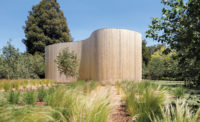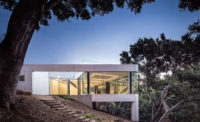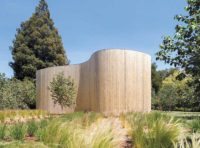Craig Hartman and his wife, Jan O’Brien—both architects—spent nearly 10 years visiting their weekend property in Sonoma County, California, before breaking ground. They stayed in a yurt on the rolling 35-acre former cattle ranch and contemplated a gentle architectural intervention. Finally, the first phase, a guest/caretaker cottage, is done, serving as the couple’s own retreat until the main house is built,
and embodying key ideas for the whole site.
Additional Content:
Jump to credits & specifications
“Beyond sustainability,” says Hartman, “we wanted land we could make environmentally even better than we’d found it.” Removing the cattle dramatically helped restore native ecosystems, allowing oak seedlings to proliferate and mature (instead of becoming grazing fodder), and protecting on-site creeks from contaminated pasture runoff. But without client pressure, the project became “like a hobby,” he recalls. “I worked on it here and there during weekends.” He savored the leisurely pace and modest scale—a welcome change from the vast structures he’s handled as a partner in SOM’s San Francisco office, where he designed, notably, California’s Oakland Cathedral and the U.S. Courthouse in L.A.. “With this house, my wife indulged me,” he says. “Though she’d built her entire practice on smaller-scale work and interiors, she generously let me design it.” (A young associate, Anesta Iwan, is collaborating on the compound, while O’Brien, as project architect, is overseeing it all.)
Nestled within a hillside oak grove, the net zero carbon cottage is composed of a “day” and “night” pavilion, joined by a canopy. Each of these volumes, totaling 840 square feet, is a rectangular tube, structured with renewable, heavy timbers and partially cantilevered to reduce the footprint. The exterior recycled-steel cladding is dark-colored to recede visually. The day pavilion contains a double-height living/dining/kitchen area, while its nighttime counterpart houses the master bedroom and art studio/guest room.
As in the future main house, the fenestration is oriented for passive cooling, privacy, and long, sweeping landscape views, as well as contemplative near ones. Heat-venting skylights with subtly colored baffles and LED components temper the interior illumination, in tandem with the changing qualities of daylight. A ground-mounted PV array, elsewhere on-site, covers the property’s energy needs while feeding excess power back into the grid.
The owners hope to make their cabin available for visiting artists, once the main house is built. When will that happen? “We were going to begin construction this spring,” says Hartman, “but now we’re putting it off another year.” Stay tuned.
CreditsArchitect: Craig W. Hartman, FAIA
Personnel in architect's firm who should receive special credit: Craig Hartman, FAIA – Project Designer Jan O’Brien, AIA – Project Architect Anesta Iwan – Project Design, Documentation and Research
Engineers Structural: Skidmore Owings & Merrill, LLP (David Shook) Mechanical: Meyers+ (Paul McGrath) Civil: Munselle Engineering (Cort Munselle)
Consultants Landscape: Tom Leader Studio
General contractor: Fairweather Associates (Simon Fairweather, Randy Straub, Jim Whittlesey, Harper Bishop, Amanda Barlow)
Photographer: Chun Y Lai Photography (Chun Lai) |
SpecificationsExterior Cladding Metal panels: Metal Sales
Roofing Metal: Metal Sales
Glazing Glass: Marvin Skylights: Velux
Doors Metal doors: Thermo Tru Wood doors: Marvin Sliding doors: La Cantina Doors, Marvin
Interior Finishes Paints and stains: Benjamin Moore
Lighting Interior ambient lighting: Q-Trans, Tech Element Exterior: Q-Trans, BK-Lighting |









Post a comment to this article
Report Abusive Comment